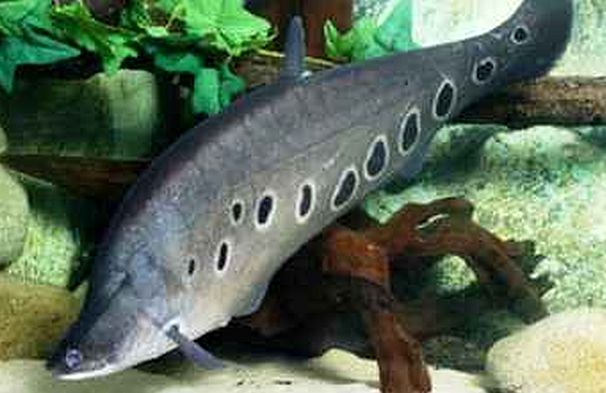The Clown Knifefish (C. ornata) is a South East Asian species that is also referred to as the Clown Featherback, Spotted Knifefish, and Spotted Featherback by tropical fish keeping enthusiasts. Its close Indian relative the Chitala chitala is also called the Clown Knifefish, Royal Clown Knifefish, Royal Spotted Knifefish, or Spotted Featherback, and is less common than C. ornata.
Clown Knifefish are found in swamps, lakes, and the moving backwaters of medium to large rivers in Thailand, Laos, Cambodia, and Vietnam.
They live close to shore and are commonly found around overhanging vegetation and docks. Juvenile fish often school among the submerged roots and aquatic plants of their range while the adults, like those of many species, are normally loaners.
Like the lybrinth fishes, the Clown Knifefish can survive in the warm stagnant waters of their range by breathing oxygen. They are a shy, highly predatorial, nocturnal species that is highly aggressive toward other fish especially as they mature.
The coloring and behavior of C. ornata and C. chitala are identical, but the Indian species grows a bit larger and reaches a length of 4 feet.
Both species have an elongated body shape with an arched back, a small dorsal fin, and a continuous single fin, that is formed by the joining of the caudal and anal fins, that runs along the underside of the body. The continuous fin allows the fish to move forward or backward with ease.
Their overall body coloring is silvery gray with variable patterns of large spots above the base of the anal fin. No two patterns are the same. Some fish have a double row of smaller spots and others may have no spots at all. Albinos forms of both species are rare but known.
Even in a home aquarium, the Clown Knifefish will grow to a length of over 3 feet. Although they spend most of their lives in the middle or bottom of the water column, they will occasionally swim to the surface to take a gulp of air or to feed.
They can be housed a 55 gallon tank until they reach around 10″ in size, but if you plan on keeping them for the long term, you need a tank of at least 200 gallons or more. A high quality filter and a couple of power heads are also needed to provide some current and a UV sterilizer should be included in the system to kill bacteria and keep down disease. Because these fish are scaleless and very sensitive to water condition changes, a high quality filter is a must, as are weekly water changes of 30 – 50%.
Clown Knifefish are nocturnal and are easily stressed. You can minimize problems with these fish by setting up a tank that mimics the slow moving lakes and rivers that they live in in the wild. Clown Knifefish appreciate a densely planted tank that has a sandy or fine gravel substrate, driftwood roots and rocks in the form of caves for them to hide in during the day, and plenty of swimming space with a few floating plants
in the tank. In short, if you provide them with well filtered water, a dimly lit tank and plenty of hiding places, you should have a happy Clown Knife.
Unfortunately, many tropical fish keeping enthusiasts purchase juvenile Clown Knifefish when they are offered for sale at only 3″ to 6″ in length. At this stage they are delicate, suseptable to stress and disease, and wind up being housed in unsuitable conditions. Most will die, but those that survive are usually hardy and long lived (up to 15 years).
Remember that the cute little 3 inch fish you bought can grow to over 3 feet long, however in an aquarium 10″ to 20″ inches is usually the maximum size. If you plan on keeping one until “death do you part”; be prepared to setup a 200 gallon tank.
Clown Knifefish are highly predatory piscivores and in the wild they mostly eat fish. In an aquarium they prefer eating fresh small fish, ghost shrimp or worms, but they can be conditioned to start eating sinking carnivore pellets or some other prepared food. Do not plan on keeping them in a community tank unless the tank mates are much larger. These fish will eat anything they can get into their wide mouths.
When shopping for a Clown Knife, avoid fish that are under 3 inches long or over 6 inches. The small ones are relatively delicate and the larger ones can be harder to get feeding.
Breeding Clown Knifefish is possible but probably won’t happen unless you have the pair in a 500 gallon or larger tank. The pair will usually lay their eggs on floating plants where the male will guard them for 6 or 7 days until they hatch out. Fry should be removed from the tank and fed baby brine shrimp until they become large enough to eat other foods.
Clown Knifefish are common and offered for sale in tropical fish shops at a size of 3″ to 6″ in length.
Minimum Tank Size: 75 – 200 gallons
Care Level: Moderate
Temperament: Semi Aggressive
Aquarium Hardiness: Hardy as adults
Water Conditions: 75 – 82° F, 2 – 10 dGH, pH 5.5-7.0
Max. Size: 3′ 6″
Color: Silver, Bronze
Tank Compatability: Mid level swimmer, aggressive to smaller fish
Diet: Carnivore
Origin: Southeast Asia
Family: Apteronotidae
Lifespan: Up to 15 years
Aquarist Experience Level: Advanced




